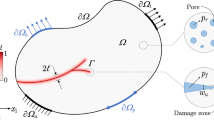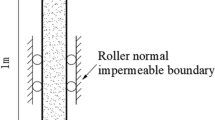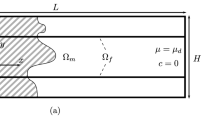Abstract
Continuum mechanics usually considers the theoretical and computational description of standard single-phasic materials in the framework of either solid mechanics, fluid mechanics or gas dynamics. However, growing complexity in material modelling combined with the request of users leads to a growing interest in porous-media mechanics, where porous solid materials with fluid or gaseous pore content are investigated on a macroscopic scale. In this regard, the present article reviews the theoretical and numerical framework for the description of geomechanical and biomechanical problems including elastic, elasto-plastic and visco-elastic solid behaviour partly combined with electro-active properties. For this purpose, the Theory of Porous Media is applied for an elegant consideration of the coupling phenomena of porous solids with pore fluids, no matter if the fluids have to be treated as inert fluids or as fluid mixtures. In the sense of a review article, different computational examples are presented to illuminate the possibilities and challenges of porous-media mechanics.
Similar content being viewed by others
References
Bowen, R.M.: Theory of mixtures. In: Eringen, A.C. (ed.) Continuum Physics, vol. 3, pp. 1–127. Academic Press, New York (1976)
Bowen, R.M.: Incompressible porous media models by use of the theory of mixtures. Int. J. Eng. Sci. 18, 1129–1148 (1980)
Bowen, R.M.: Compressible porous media models by use of the theory of mixtures. Int. J. Eng. Sci. 20, 697–735 (1982)
de Boer, R.: Trends in Continuum Mechanics of Porous Media, vol. 18. Theory and Applications of Transport in Porous Media. Springer, Dodrecht (2005)
Ehlers, W.: Foundations of multiphasic and porous materials. In: Ehlers, W., Bluhm, J. (eds.) Porous Media: Theory, Experiments and Numerical Applications, pp. 3–86. Springer, Berlin (2002)
Ehlers, W.: Challenges of porous media models in geo- and biomechanical engineering including electro-chemically active polymers and gels. Int. J. Adv. Eng. Sci. Appl. Math. 1, 1–24 (2009)
Truesdell, C.: Rational Thermodynamics, 2nd edn. Springer, New York (1984)
Coleman, B.D., Noll, W.: The thermodynamics of elastic materials with heat conduction and viscosity. Arch. Ration. Mech. Anal. 13, 167–178 (1963)
Ehlers, W.: On thermodynamics of elasto-plastic porous media. Arch. Mech. 41, 73–93 (1989)
Ehlers, W., Ellsiepen, P.: PANDAS: Ein FE-System zur Simulation von Sonderproblemen der Bodenmechanik. In: Wriggers, P., Meißner, U., Stein, E., Wunderlich, W. (eds.) Finite Elemente in der Baupraxis-FEM’98, pp. 391–400. Ernst & Sohn, Berlin (1998)
Ehlers, W., Ellsiepen, P., Ammann, M.: Time-and space-adaptive methods applied to localization phenomena in empty and saturated micropolar and standard porous materials. Int. J. Numer. Methods Eng. 52, 503–526 (2001)
Ehlers, W., Acartürk, A., Karajan, N.: Advances in modelling saturated soft biological tissues and chemically active gels. Arch. Appl. Mech. 80, 467–478 (2010)
Ehlers, W., Karajan, N., Markert, B.: An extended biphasic model for charged hydrated tissues with application to the intervertebral disc. Biomech. Model. Mechanobiol. 8, 233–251 (2009)
Ehlers, W., Avci, O.: Stress-dependent hardening and failure surfaces of dry sand. Int. J. Numer. Anal. Methods Geomech. 37(8), 787–809 (2013)
Ehlers, W., Häberle, K.: Interfacial mass transfer during gas-liquid phase change in deformable porous media with heat transfer. Transp. Porous Med. 114, 525–556 (2016)
Schenke, M., Ehlers, W.: Parallel solution of volume-coupled multi-field problems using an Abaqus-PANDAS software interface. Proc. Appl. Math. Mech. 15, 419–420 (2015)
Hashin, Z.: Analysis of composite materials-a survey. ASME J. Appl. Mech. 50, 481–505 (1983)
Ehlers, W.: Effective stresses in multiphasic porous media: a thermodynamic investigation of a fully non-linear model with compressible and incompressible constituents. Geomech. Energy Environ. 15, 35–46 (2018)
Taylor, C., Hood, P.: A numerical solution of the Navier-Stokes equations using the finite element technique. Comput. Fluids 1, 73–100 (1973)
Brezzi, F., Fortin, M.: Mixed and Hybrid Finite Element Methods. Springer, New York (1991)
Brooks, R.H., Corey, A.T.: Hydraulic Properties of Porous Media, Hydrology Papers, vol. 3. Colorado State University, Fort Collins (1964)
Wieners, C., Graf, T., Ammann, M., Ehlers, W.: Parallel Krylov methods and the application to 3-d simulations of a triphasic porous media model in soil mechanics. Computat. Mech. 36, 409–420 (2005)
Dalton, J.: On the expansion of elastic fluids by heat. Essay IV of Mem. Lit. Philos. Soc. Manch. 5, 595–602 (1802)
de Borst, R.: Simulation of strain localization: a reappraisal of the Cosserat continuum. Eng. Comput. 8, 317–332 (1991)
Steinmann, P.: A micropolar theory of finite deformation and finite rotation multiplicative elasto-plasticity. Int. J. Solids Strucut. 31, 1063–1084 (1994)
Ehlers, W., Volk, W.: On theoretical and numerical methods in the theory of porous media based on polar and non-polar elastoplastic solid materials. Int. J. Solids Struct. 35, 4597–4617 (1998)
Needleman, A.: Material rate dependence and mesh sensitivity in localization problems. Comput. Methods Appl. Mech. Eng. 67, 69–85 (1988)
Mühlhaus, H.-B., Aifantis, E.C.: A variational principle for gradient plasticity. Int. J. Solids Struct. 28, 845–857 (1991)
de Borst, R., Sluys, L.J., Mühlhaus, H.-B., Pamin, J.: Fundamental issues in finite element analysis of localization of deformation. Eng. Comput. 10, 99–121 (1993)
Ehlers, W., Graf, T., Ammann, M.: Deformation and localization analysis in partially saturated soil. Comput. Methods Appl. Mech. Eng. 193, 2885–2910 (2004)
Griffith, A.A.: The phenomena of rupture and flow in solids. Phil. Trans. R. Soc. Lond. A 221, 163–198 (1921)
Irwin, G.R.: Analysis of stresses and strains near the end of a crack traversing a plate. J. Appl. Mech. 24, 361–364 (1957)
Barenblatt, G.I.: The mathematical theory of equilibrium cracks in brittle fracture. Adv. Appl. Mech. 7, 55–129 (1962)
Miehe, C., Welschinger, F., Hofacker, M.: Thermodynamically consistent phase-field models of fracture: variational principles and multi-field FE implementations. Int. J. Numer. Methods Eng. 83, 1273–1311 (2010)
Belytschko, T., Black, T.: Elastic crack growth in finite elements with minimal remeshing. Int. J. Numer. Methods Eng. 45, 601–620 (1999)
Moës, N., Belytschko, T.: Extended finite element method for cohesive crack growth. Eng. Fract. Mech. 69, 813–833 (2002)
Miehe, C., Hofacker, M., Welschinger, F.: A phase field model for rate-independent crack propagation: Robust algorithmic implementation based on operator splits. Comput. Methods Appl. Mech. Eng. 199, 2765–2778 (2010)
Ehlers, W., Luo, C.: A phase-field approach embedded in the Theory of Porous Media for the description of dynamic hydraulic fracturing. Comput. Methods Appl. Mech. Eng. 315, 348–368 (2017)
Ehlers, W., Luo, C.: A phase-field approach embedded in the theory of porous media for the description of dynamic hydraulic fracturing, Part II: the crack-opening indicator. Comput. Methods Appl. Mech. Eng. 341, 429–442 (2018)
Acartürk, A.: Simulation of charged hydrated porous media, Dissertation, Report No. II-18 of the Institute of Applied Mechanics (CE), University of Stuttgart (2009)
Ehlers, W., Eipper, G.: Finite elastic deformations in liquid-saturated and empty porous solids. Transp. Porous Med. 34, 179–191 (1999)
Karajan, N.: An extended biphasic description of the inhomogeneous and anisotropic intervertebral disc. Dissertation Thesis, Report No. II-19 of the Institute of Applied Mechanics (CE), University of Stuttgart (2009)
Ehlers, W., Wagner, A.: Constitutive and computational aspects in tumor therapies of multiphasic brain tissue. In: Holzapfel, G.A., Kuhl, E. (eds.) Computer Models in Biomechanics: from Nano to Macro, pp. 263–276. Springer, Dordrecht (2013)
Ehlers, W., Wagner, A.: Multi-component modelling of human brain tissue: a contribution to the constitutive and computational description of deformation, flow and diffusion processes with application to the invasive drug-delivery problem. Comput. Methods Biomech. Biomed. Eng. 18, 861–879 (2015)
Markert, B., Ehlers, W., Karajan, N.: A general polyconvex strain-energy function for fiber-reinforced materials. Proc. Appl. Math. Mech. 5, 245–246 (2005)
Bobo, R.H., Laske, D.W., Akbasak, A., Morrison, P.F., Dedrick, R.L., Oldfield, E.H.: Convection-enhanced delivery of macromolecules in the brain. Proc. Natl Acad. Sci. USA (PNAS) 91, 2076–2080 (1994)
Fink, D., Wagner, A., Ehlers, W.: Application-driven model reduction for the simulation of therapeutic infusion processes in multi-component brain tissue. J. Comput. Sci. 24, 101–115 (2018)
Further Reading
Biot, M.A.: Le problème de la consolidation de matières argileuses sous une charge. Annales de la Société scientifique de Bruxelles B55, 110–113 (1935)
Biot, M.A.: General theory of three-dimensional consolidation. J. Appl. Phys. 12, 155–164 (1941)
Biot, M.A.: Theory of propagation of elastic waves in a fluid-saturated porous solid, I. Low frequency range. J. Acoust. Soc. Am. 28, 168–178 (1956)
Biot, M.A.: Theory of propagation of elastic waves in a fluid-saturated porous solid, II. Higher frequency range. J. Acoust. Soc. Am. 28, 179–191 (1956)
Biot, M.A.: Variational Lagrangian-thermodynamics of nonisothermal finite strain mechanics of porous solids and thermomolecular diffusion. Int. J. Solids Struct. 13, 579–597 (1977)
Biot, M.A.: Variational irreversible thermodynamics of heat and mass transfer in porous solids: new concept and methods. Q. Appl. Math. 36, 1–38 (1978)
de Boer, R.: Theory of Porous Media. Springer, Berlin (2000)
Borja, R.I., Regueiro, R.A.: Dynamics of porous media at finite strain. Comput. Methods Appl. Mech. Eng. 193, 3837–3870 (2004)
Ehlers, W.: Porous media in the light of history. In: Stein, E. (ed.) The History of Theoretical, Material and Computational Mechanics–Mathematics Meets Mechanics and Engineering. Lecture Notes in Applied Mathematics and Mechanics (LAMM) vol. 1, pp. 211–227. Springer, Heidelberg (2014)
Lewis, R.W., Schrefler, B.A.: The Finite Element Method in the Deformation and Consolidation of Porous Media. Wiley, Chichester (1987)
Bishop, A.W.: The effective stress principle. Teknisk Ukeblad 39, 859–863 (1959)
Skempton, A.W.: Significance of Terzaghi’s concept of effective stress (Terzaghi’s discovery of effective stress). In: Bjerrum, L., Casagrande, A., Peck, R.B., Skempton, A.W. (eds.) From Theory to Practice in Soil Mechanics, pp. 42–53. Wiley, New York (1960)
de Boer, R., Ehlers, W.: The development of the concept of effective stresses. Acta Mech. 83, 77–92 (1990)
Lade, P., de Boer, R.: The concept of effective stress for soil, concrete and rock. Géotechnique 47, 61–78 (1997)
Borja, R.I.: On the mechanical energy and effective stress in saturated and unsaturated porous continua. Int. J. Solids Struct. 43, 1764–1786 (2006)
Jiang, Y., Einav, I., Liu, M.: A thermodynamic treatment of partially saturated soils revealing the structure of effective stress. J. Mech. Phys. Solids 100, 131–146 (2017)
Ehlers, W., Ammann, M., Diebels, S.: h-adaptive FE methods applied to single- and multiphase problems. Int. J. Numer. Methods Eng. 54, 219–239 (2002)
Ehlers, W., Ellsiepen, P.: Theoretical and numerical methods in environmental continuum mechanics based on the theory of porous media. In: Schrefler, B.A. (ed.) Environmental Geomechanics, CISM Courses and Lectures No. 417, pp. 1–81. Springer, Wien (2001)
Boone, T.J., Ingraffea, A.R.: A numerical procedure for simulation of hydraulically driven fracture propagation in poroelastic media. Numer. Anal. Methods Geomech. 14, 27–47 (1990)
Boone, T.J., Detournay, E.: Response of a vertical hydraulic fracture intersecting a poroelastic formation bounded by semi-infinite impermeable elastic layers. Int. J. Rock Mech. Min. Sci. Geomech. 27, 189–197 (1990)
Detournay, E.: Propagation regimes of fluid-driven fractures in impermeable rocks. Int. J. Geomech. 4, 35–45 (2004)
Heider, Y., Reiche, S., Siebert, P., Markert, B.: Modeling of hydraulic fracturing using a porous-media phase-field approach with reference to experimental data. Eng. Fract. Mech. 202, 116–134 (2018)
Mikelić, A., Wheeler, M.F., Wick, T.: A phase-field method for propagating fluid-filled fractures coupled to a surrounding porous medium. SIAM Multiscale Model. Simul. 13, 367–398 (2015)
Markert, B., Heider, Y.: Coupled multi-field continuum methods for porous media fracture. In: Mehl, M., Bischoff, M., Schäfer, M. (eds.) Recent Trends in Computational Engineering-CE2014, pp. 167–180. Springer, Berlin (2015)
Pillai, U., Heider, Y., Markert, B.: A diffusive dynamic brittle fracture model for heterogeneous solids and porous materials with implementation using a user-element subroutine. Comput. Mater. Sci. 153, 36–47 (2018)
Remij, E.W., Remmers, J.J.C., Huyghe, J.M., Smeulders, D.M.J.: The enhanced local pressure model for the accurate analysis of fluid pressure driven fracture in porous materials. Comput. Methods Appl. Mech. Eng. 286, 293–312 (2015)
Ateshian, G.A.: Mixture theory for modeling biological tissues: Illustrations from articular cartilage. In: Holzapfel, G., Ogden, R.W. (eds.) Biomechanics: Trends in Modeling and Simulation, pp. 1–51. Springer, Cham (2017)
Ding, J., Remmers, J.J.C., Leszczynski, S., Huyghe, J.M.: Swelling driven crack propagation in large deformation in ionized hydrogel. J. Appl. Mech. 85, 021007 (2018)
Huyghe, J.M., Janssen, J.D.: Thermo-chemo-electro-mechanical formulation of saturated charged porous solids. Transp. Porous Media 34, 129–141 (1999)
Huyghe, J.M., Molenaar, M.M., Baajens, F.P.: Poromechanics of compressible charged porous media using the theory of mixtures. J. Biomech. Eng. 129, 776–785 (2007)
Huyghe, J.M., Wilson, W., Malakpoor, K.: On the thermodynamical admissibility of the triphasic theory of charged hydrated tissues. J. Biomech. Eng. 131, 044504 (2009)
Huyghe, J.M.: Biaxial testing of canine annulus fibrosus tissue under changing salt concentrations. Anais da Academia Brasileira de Cincias 82, 145–151 (2010)
Kraaijeveld, F.: Propagating discontinuities in ionized porous media. Dissertation Thesis, TU of Eindhoven (2009)
Lai, W.M., Hou, J.S., Mow, V.C.: A triphasic theory for the swelling and deformation behaviors of articular cartilage. J. Biomech. Eng. 113, 245–258 (1991)
Mow, V.C., Guo, X.E.: Mechano-electrochemical properties of articular cartilage: their inhomogeneities and anisotropies. Annu. Rev. Biomed. Eng. 4, 175–209 (2002)
Bobo, R.H., Laske, D.W., Akbasak, A., Morrison, P.F., Dedrick, R.L., Oldfield, E.H.: Convection-enhanced delivery of macromolecules in the brain. Proc. Natl. Acad. Sci. 91, 2076–2080 (1994)
Fung, Y.-C.: Biomechanics: Mechanical Properties of Living Tissues. Springer, Berlin (2013)
Goriely, A., Geers, M.G., Holzapfel, G.A., Jayamohan, J., Jérusalem, A., Sivaloganathan, S., Squier, W., van Dommelen, J.A., Waters, S., Kuhl, E.: Mechanics of the brain: perspectives, challenges, and opportunities. Biomech. Model. Mechanobiol 14, 931–965 (2015)
Holzapfel, G.A.: Biomechanics of soft tissue. Handb Mater Behav Model 3, 1049–1063 (2001)
Miller, K., Chinzei, K.: Constitutive modelling of brain tissue: experiment and theory. J. Biomech. 30(11), 1115–1121 (1997)
Linninger, A.A., Somayaji, M.R., Mekarsk, M., Zhang, L.: Prediction of convection enhanced drug delivery to the human brain. J. Theor. Biol. 250, 125–138 (2008)
Ricken, T., Schwarz, A., Bluhm, J.: A triphasic model of transversely isotropic biological tissue with applications to stress and biologically induced growth. Comput. Mater. Sci. 39, 124–136 (2007)
Sarntinoranont, M., Chen, X., Zhao, J., Mareci, T.M.: Computational model of interstitial transport in the spinal cord using diffusion tensor imaging. Ann. Biomed. Eng. 34, 1304–1321 (2006)
Støverud, K.H., Darcis, M., Helmig, R., Hassanizadeh, S.M.: Modeling concentration distribution and deformation during convection-enhanced drug delivery into brain tissue. Transp. Porous Media 92, 119–143 (2011)
Acknowledgements
We would like to thank the German Research Foundation (DFG) for financial support of the project both within the Cluster of Excellence in Simulation Technology (SimTech) under Grant Number EXC 310 and within the Collaborative Research Centre “Interface-Driven Multi-Field Processes in Porous Media” under Grant Number CRC 1313 at the University of Stuttgart.
Author information
Authors and Affiliations
Corresponding author
Additional information
Publisher's Note
Springer Nature remains neutral with regard to jurisdictional claims in published maps and institutional affiliations.
Rights and permissions
About this article
Cite this article
Ehlers, W., Wagner, A. Modelling and simulation methods applied to coupled problems in porous-media mechanics. Arch Appl Mech 89, 609–628 (2019). https://doi.org/10.1007/s00419-019-01520-5
Received:
Accepted:
Published:
Issue Date:
DOI: https://doi.org/10.1007/s00419-019-01520-5
Keywords
- Coupled problems
- Theory of Porous Media
- Consolidation process
- Slope failure
- Hydraulic fracturing
- Electro-active materials
- Medical drug delivery















